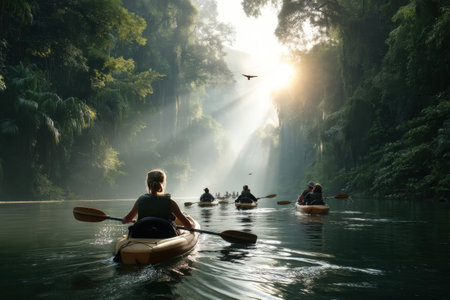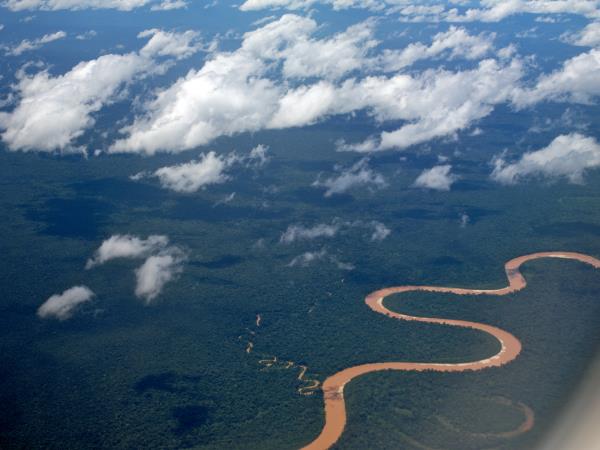Muyuna Lodge: An Italian Wildlife Photographer's Amazon Expedition

The Amazon. Just the name conjures images of vibrant biodiversity, mysterious depths, and a raw, untamed beauty that has captivated me since childhood. As a wildlife photographer and conservationist, I've dedicated my life to documenting the natural world, from jaguars in the Pantanal to the incredible species found within the Amazon rainforest. Driven by a deep desire to experience this ecosystem firsthand and support sustainable practices, I embarked on a 7-day expedition to the Muyuna Lodge, nestled within the Pacaya Samiria National Reserve in Peru. My mission: to capture the soul of the Amazon through my lens, and to share the importance of responsible tourism in this vital region. Join me as I recount my journey through the flooded forests of April, a time of high water that unveils a unique perspective on the rainforest.
Day 1: Arrival and Canopy Kayaking
The journey to Muyuna Lodge is an adventure in itself. From Iquitos, a bustling city on the edge of the Amazon, a motorized canoe carried me deep into the Pacaya Samiria National Reserve. The landscape transformed from sprawling cityscapes to dense foliage, a visual promise of the wonders to come. Upon arriving at the lodge, I immediately felt a sense of tranquility and connection to nature. The lodge's commitment to sustainable tourism was evident in its design and operations, seamlessly blending into the environment.
My first activity was nothing short of magical: kayaking through the flooded forest canopy at sunset. Paddling silently through the calm water, I was immersed in a symphony of sounds – the calls of the distinctive hoatzins, often called "stinkbirds," and the playful rustling of monkeys overhead. The golden light filtering through the leaves created a breathtaking spectacle, offering a unique perspective of the rainforest from above. I captured this moment with my Nikon D850, using settings of ISO 400, f/5.6, and 1/250s to showcase the luminous glow.
Day 2: Caiman Spotting and Nighttime Jungle Sounds
The nighttime jungle holds a different kind of allure, and I was eager to experience it. Armed with a flashlight and accompanied by an experienced guide, we embarked on a caiman spotting tour. The stillness of the river was broken only by the gentle hum of the boat's engine and the hushed whispers of our guide. As the spotlight scanned the water's edge, the reflective eyes of the caimans emerged, piercing the darkness.
Photographing in such low light presented a challenge, but I was determined to capture the essence of the experience. Using a monopod for stability, I set my camera to ISO 3200, f/2.8, and 1/60s to capture the intensity of the moment. The cacophony of sounds in the jungle at night was truly unforgettable – the incessant chirping of cicadas, the croaking of frogs, and the distant calls of unknown animals. This immersive experience highlighted the incredible biodiversity that thrives under the cloak of darkness. This is the best time to visit Pacaya Samiria National Reserve if you want to immerse yourself in the nighttime symphony.
Day 3: Medicinal Plant Hike and Indigenous Knowledge
A journey into the Amazon is incomplete without learning about its incredible botanical resources. On Day 3, I joined a jungle hike led by a local indigenous guide, whose ancestral knowledge of medicinal plants was truly astounding. With each step, he unveiled the secrets hidden within the tangled roots, vibrant fungi, and deep shade beneath the canopy.
He explained the traditional uses of various plants, from remedies for common ailments to powerful healing agents. I was particularly fascinated by the sustainable harvesting practices he demonstrated, ensuring the continued health of the ecosystem. The visual textures of the jungle floor provided endless photographic opportunities, and I focused on capturing the intricate details of the plant life using my 24-70mm lens. What are the most sustainable practices at Muyuna Lodge? They learn from indigenous populations and incorporate their traditions.
Day 4: Ribereño Community Visit and Sustainable Practices
Muyuna Lodge's commitment to sustainable tourism extends beyond environmental conservation to include partnerships with local ribereño communities. A visit to one of these communities was a highlight of my trip, offering a profound cultural exchange and valuable lessons about their sustainable lifestyle.
I was warmly welcomed by the community members, who shared their traditional fishing techniques, their use of natural resources, and their intricate woven crafts. Seeing the smiles of the children and learning about their way of life was incredibly inspiring. I was particularly impressed by their skill in building traditional houses from sustainably harvested materials, showcasing their deep understanding of the rainforest ecosystem. The ethical wildlife photography tours Peru emphasize this cultural connection.

Day 5: Paiche Feast and River Life Photography
No trip to the Amazon is complete without savoring its culinary delights. At the lodge, I had the opportunity to indulge in a paiche (arapaima) feast, a local delicacy cooked in bijao leaves and accompanied by yucca and plantains. The presentation was beautiful, and the flavors were simply exquisite.
After the delicious meal, I dedicated the afternoon to capturing the bustling river life from the canoe. Local boats carrying goods and people crisscrossed the river, children played in the water, and fishermen cast their nets with practiced ease. I used my camera settings of ISO 200, f/8, and 1/500s to capture the vibrant colors and sharp focus, aiming to portray the energy and vitality of the Amazon river. This allowed for optimal sharpness and rich color capture in the bright daylight.
Day 6: Dawn Macaw Photography and Conservation Challenges
The Amazon awakens with a burst of color and sound, and there's no better way to witness it than by photographing macaws at dawn. An early morning boat trip took me to a prime viewing spot, where I was greeted by the sight of these magnificent birds soaring against the backdrop of the rising sun.
The vibrant colors of their plumage were truly breathtaking, and I used burst mode on my camera with settings of ISO 400, f/5.6, and 1/1000s to capture their flight in stunning detail. However, beneath this beauty lies a harsh reality. The Amazon faces significant conservation challenges, including deforestation and illegal mining. Muyuna Lodge actively supports initiatives to protect the rainforest, working with local communities to promote sustainable practices and combat these threats. Choosing an Amazon Rainforest Eco Lodge like Muyuna Lodge is critical in supporting conservation.
Day 7: Departure and Reflections
As my journey to Muyuna Lodge came to an end, I reflected on the profound impact it had on me. The Amazon is a treasure trove of biodiversity, a place of incredible beauty and vital ecological importance. My experience reinforced the importance of responsible tourism in the region, ensuring that future generations can also witness its wonders.
For travelers looking to visit the Amazon responsibly, I highly recommend choosing eco-lodges like Muyuna that support local communities and minimize their environmental impact. This includes using biodegradable toiletries, respecting wildlife, and avoiding single-use plastics. Sustainable Tourism Peruvian Amazon protects this vital ecosystem for future generations.
The Amazon is calling. Let’s ensure its vibrant symphony continues to play for years to come. Consider supporting conservation efforts in the Amazon and visiting the region responsibly. What is the best eco-lodge in the Peruvian Amazon? In my experience, Muyuna Lodge provides exceptional service with a deep commitment to conservation.
